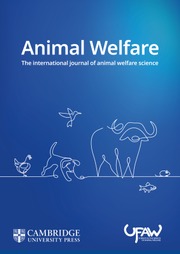Article contents
Some Practical Solutions to Welfare Problems in Dog Breeding
Published online by Cambridge University Press: 11 January 2023
Abstract
This paper reviews the history of the establishment of dog breeds, summarizes current health and resultant welfare problems and makes some positive suggestions for their resolution. Some breed standards and selection practices run counter to the welfare interests of dogs, to the extent that some breeds are characterized by traits that may be difficult to defend on welfare grounds. Meanwhile, little selection pressure seems to be exerted on some traits that would improve animal welfare and produce dogs better suited to modern society. Unfortunately, the incidence of certain inherited defects in some breeds is unacceptably high, while the number of registered animals of certain breeds within some countries is so low as to make it almost impossible for breeders to avoid mating close relatives. There are several constructive ways to overcome these challenges. Breed associations can ensure that reduction of welfare problems is one of their major aims; they can review breed standards; they can embrace modern technology for animal identification and pedigree checking; they can allow the introduction of ‘new ‘ genetic material into closed stud-books; and they can encourage collaboration with geneticists in identifying and using DNA markers for the control of inherited disorders. There should be a concerted effort to produce and evaluate as companion animals first-cross (F1) hybrids from matings between various pairs of breeds. Finally, geneticists must learn to communicate their science better and in a language that non-geneticists can understand.
Information
- Type
- Research Article
- Information
- Animal Welfare , Volume 8 , Issue 4: Special Issue: Genetics and Animal Welfare , November 1999 , pp. 329 - 341
- Copyright
- © 1999 Universities Federation for Animal Welfare
References
- 90
- Cited by

